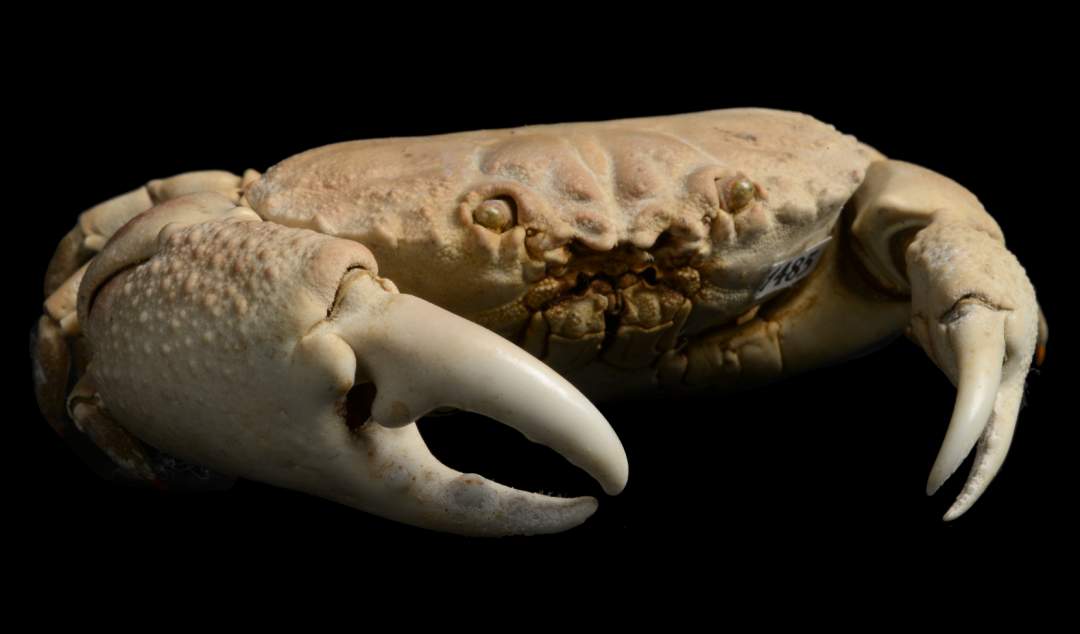History of the Crustacean Section
The Crustacea section is one of the oldest in Senckenberg. It was founded by Eduard Rüppell after his return from Arabia in 1828 and was initially headed by him. In 1830 he published his first work on this taxon on 24 crustaceans from the Red Sea (Rüppell, 1830). But even before that, in the 1820s, Rüppell undertook his first expedition to Egypt, and it is likely that he was already collecting marine animals at that time, but there is no evidence for this. The first handwritten record of a crustacean deposited in the Senckenberg collection dates from 1826, and is a specimen of the crab Ashtoret lunaris (Forskål, 1775), which Rüppell collected in the Red Sea. A handwritten catalogue by Adolf Reuss, who subsequently passed on the section in consultation with E. Rüppell, dates from 1832. After E. Rüppell had abandoned crustacean research around 1834, the section was co-administered by members of other sections (e.g., the botanist J. B. G. W. Fresenius) until 1878.
Only on May 26, 1878, when Ferdinand Richters [*1849 -✝1914] took over the Section, did a phase of own scientific work begin. Another handwritten catalogue of the collection (1880) and a detailed card index, which is very useful for historical research, date from this period.
In 1912 Alexander Sendler [*1878 – ✝1914] joined the section as a further collaborator. After the death of F. Richters on 3 July 1914 he took over the leadership of the section. Only three months later he also fell in the First World War [10 October 1914, near St. Mihiel south of Verdun]. With his death, the section was again orphaned and was co-administered by the custodians for invertebrates (F. Haas, A. Zilch).
Since 1946, the Crustacea Section has again been under continuous scientific management, after Richard Bott [*1902-✝1974] returned from captivity at the end of the Second World War. He worked almost exclusively on crayfish and freshwater crabs and built up a large collection of type material. The number of publications and monographs from the section also skyrocketed during this time.
After the death of Richard Botts on 27 January 1974, Michael Türkay took over the Crustacea Section, first as an assistant, then (from 1976) as a full-time employee. Michael Türkay (*1948-✝2015), came to Senckenberg as a young student. From 1974 until his death he worked on decapod crustaceans from the deep sea and the Orient, but also from the North Sea and the Mediterranean. Türkay maintained close ties with “Senckenberg am Meer ” in Wilhelmshaven, where he conducted the summer field courses of the Senckenberg School for Young Museum Technicians every year. His good relations with Japanese scientists (among others: T. & K. Sakai, K. Matsuzawa) led to a series of huge collection donations of Japanese crustaceans, which is probably one of the world’s largest Japanese crab collections outside Japan.
With the expansion of German marine research, much deep-sea material entered the collection and the focus of research shifted more towards marine decapods. Further information on the history of the section can be read in articles by M. Türkay in “Natur und Museum” (May 1981, pages 151-157) and Senckenberg-Buch 68 (1992). Michael Türkay died on 9 September 2015 at the age of 67.
Selected highlights of the last century and the beginning of the 21st century are extensive monographs on crayfish and freshwater crayfish (Bott, 1955; Türkay 1974, 1975) as well as extensive work on deep-sea decapods from the Red Sea (Türkay 1986) and various publications on the long-term monitoring of Dogger Bank in the North Sea (e.g. Türkay 1991, 1992; Türkay & Kröncke 2004; Sonnewald & Türkay 2010, 2012a, b, c).
Since April 2017 Angelika Brandt has been curator of the section. The collection thus gained a further focus, the peracarid crustaceans (Peracarida) and especially the isopods. As a result, the Crustacea collection now reaches an internationally significant size in terms of isopods. Mrs. Brandt had already cooperated with the Senckenberg Research Institute for a long time before taking up her position. She was a member of the founding commission of the German Centre for Marine Biodiversity Research (DZMB ) in Wilhelmshaven and Hamburg as part of the Senckenberg Research Institute.
Within the framework of the Census of Marine Life, A. Brandt participated in the steering committees of the Antarctic (CAML – Census of the Diversity of Antarctic Marine Life) and the deep-sea field project (CeDAMar – Census of Diversity of Abyssal Marine Life). Her work documented the high biodiversity of deep-sea invertebrates in the Southern Ocean (e.g. Brandt et al. 2007). Brandt’s current research focuses on the systematics, ecology and evolution of peracarid crustaceans, especially isopods, from deep-sea and polar habitats. In addition, the Section continues to work in the Red Sea, the Arabian Sea, the North Sea and the Baltic.
